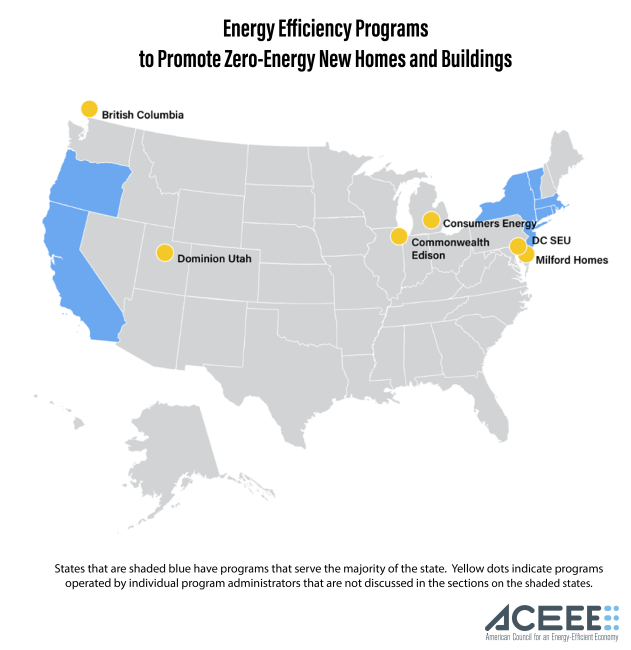As building energy codes become more stringent and interest in decarbonization increases, a growing number of energy efficiency programs are focusing on encouraging and assisting buildings that are zero-energy and zero-energy-ready. At least 20 such programs for new construction and major renovation have emerged in the United States and British Columbia, many of them recently, according to an ACEEE topic brief released today.
Together, these programs have an annual budget of about $65 million. They have collectively completed nearly 200 single-family homes, about 900 apartments in multifamily buildings, and 74 commercial buildings (with the commercial space totaling more than two million square feet of floor area). Affordable housing accounts for a significant portion of the multifamily projects. Many additional projects are in process.
What Is a Zero-Energy Building?
Our new topic brief discusses these programs and the push to construct homes and buildings that produce as much energy as they use. Such buildings fall into two categories: A zero-energy building is an energy-efficient building that, over the course of a year, produces an amount of onsite energy (typically from photovoltaic panels) that equals or exceeds the energy it buys from utilities plus the energy losses from generation and transmission. Zero-energy-ready buildings are typically highly efficient—efficient enough to be operated with onsite energy but lacking the solar energy systems needed to make the building truly zero-energy. A few programs promote zero-carbon buildings, which emit no net carbon over the course of a year.
Why Zero-Energy Buildings?
For the United States to dramatically reduce greenhouse gas emissions, we need to build new homes and buildings to minimize energy use and emissions, which means zero-energy, or near-zero-energy construction. ACEEE’s 2019 Halfway There study found that zero-energy new buildings are a key ingredient in efforts to cut U.S. energy use and greenhouse gas emissions in half by 2050, with remaining needed emissions reductions coming from no- and low-emissions energy sources. Furthermore, zero-energy buildings generally have a variety of nonenergy benefits relative to standard buildings, such as improved comfort, improved occupant health and productivity, more room for living and working (because less space is needed for heating and cooling systems), and higher occupancy rates and resale value because of the attractiveness of the zero-energy concept to building purchasers and renters.
The Economics of Zero-Energy Homes and Buildings
Zero-energy homes and buildings often cost a little more to build than conventional homes and buildings, but as experience is gained, costs are going down. Some of these costs can be offset by the savings made possible by very low energy use, which avoids the need for gas lines in buildings and allows the use of simple and relatively inexpensive heating and cooling systems. A study by the Massachusetts chapter of the U.S. Green Building Council found that zero-energy designs could typically reduce building energy use by 44–56% and reduce total building costs (mortgage, energy, and other costs discounted over 30 years) by 0.3–9.8%. In its primary scenario, the simple payback period on incremental costs ranged from 6 to 19 years depending on building type.
New-Construction Programs
For many years, utilities and other program administrators have operated programs to improve the efficiency of new homes and buildings. These programs also generally cover major renovations to existing buildings. Typically, these programs use current building energy codes as a base and provide technical assistance and financial incentives for homes and buildings that are significantly “above code.”
Zero-energy programs often build on these frameworks. For example, new-home programs may have more-stringent specifications and higher incentives for zero-energy-ready homes and sometimes also provide incentives for solar systems.
ACEEE’s New Topic Brief
Our new brief, Programs to Promote Zero-Energy New Homes and Buildings, finds that most of the 20 programs we identified and analyzed focus on zero-energy-ready construction, but several have substantial zero-energy components. The programs are in Canada’s British Columbia, Washington, D.C., and 12 U.S. states.
We also find that:
- Three program implementers have five or more years of experience with these programs and dominate the project completion counts. Particularly notable are the Energy Trust of Oregon commercial program, NYSERDA multifamily and commercial programs, and Efficiency Vermont programs addressing single-family, multifamily, and commercial buildings as well as modular housing.
- Programs report many lessons learned:
- Residential programs find that training for builders is important, as are special efforts to target the largest builders.
- Commercial programs find that building a community of practitioners is very important, as is intervening early in the design process and using this early intervention to set and follow through on energy design goals.
- It is useful to have simple incentive structures that are easy for builders, designers, and developers to understand.
- The multiple benefits of zero-energy homes and buildings need to be highlighted.
Zero-energy building programs are an important contributor to efforts to transform new-construction markets and ultimately make zero-energy and zero-carbon buildings common practice.


